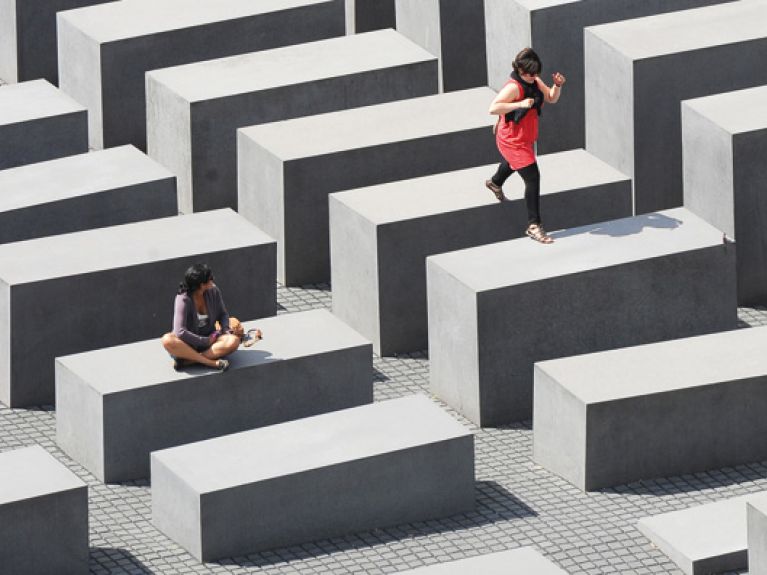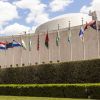Culture of remembrance
Professor Aleida Assmann describes the changing attitude towards remembrance 70 years after the end of the Second World War.

Anniversaries provide self-reassurance. They offer a moment of respite to reflect on one’s position in history. This can be done in a triumphalist, in a remorseful or in an otherwise self-critical way. However, it always involves not only letting go of what has gone before, but re-establishing contact with it in a new way. After all, the present, the point from which we look back, is constantly moving forward along the time axis and, as a result, the preconditions and challenges affecting the act of remembrance also change. How is our view of history changing 70 years after the liberation of Auschwitz and the end of the Second World War? And what are the new challenges?
In Europe since the Second World War we have seen the development of a new culture of remembrance that subverts old patterns of national self-heroisation based exclusively on pride or suffering and also expands self-image to include elements of self-criticism. This has been an arduous process that is by no means complete. Following the liberation of the concentration camps by the Allies in the early months of 1945, the crimes against humanity committed by the Nazi state were plainly obvious for the world to see. At the time the victorious powers were concerned to swiftly punish those responsible, but there was also a strong political consensus that this past should be overcome as soon as possible with a view to the future. “If Europe is to be saved from infinite misery, and indeed from final doom,” said Winston Churchill in 1946, “there must be an act of faith in the European family and an act of oblivion against all the crimes and follies of the past.”
This position proved expedient to the integration of the two German states into the new alliances of the Cold War, but did not particularly favour the development of a culture of remembrance. We know how sluggishly this process gained momentum in divided post-war Germany: for a long time in the West there was a “communicative refusal to mention” personal ties with the Nazi regime, while in the East the mythologisation of the heroic resistance eventually became a foundation of the state. After a radical historical break like 1945 it is clearly much easier for people to change direction than to change their thinking. The willingness and ability to adapt to the respective new political system was great among the members of the war generation, but a broader inner transformation and change in values that also included responsibility for Nazi crimes was only realised in West Germany with the generational change of the 1968 generation and in East Germany only after the fall of the Wall in 1989. Federal President Richard von Weizsäcker’s famous speech on 8 May 1985 (“8 May was a day of liberation”) is today generally recognised as a historic milestone; the president, who died in February 2015, confirmed this change of values as a reason of state for West Germany and thereby simultaneously laid the foundation for a new culture of remembrance. After the collapse of the GDR, this course of self-critical remembrance, one that was also compatible with European remembrance, was continued in reunified German.
At that time, self-appointed prophets prematurely spoke of the “end of history”, because the polar tension of the Cold War had been removed. What was actually taking place in many European countries, however, was the erosion of many national myths. Historians began to research the history of their countries during the Second World War in greater detail and in the process filled in the gaps in French, Austrian, Polish and Swiss history books on the subjects of collaborators and war crimes. This reconquest of repressed history was bound up with new recognition of traces, relics and, not least, witness reports of the victims and survivors of the Nazi terror. The end of the contribution of contemporary witnesses, who played a major part in developing the German culture of remembrance and supported it through their appearances in schools and memorial centres, is currently the focus of concerned debate. How will remembrance change when it has to forego these important pillars of living memory and experience? How will it be possible to pass on the memory when the memories of the primary witnesses are no longer available. Since the 1990s measures have been taken to cross this historical threshold: a video archive already exists that stores nearly 70,000 voices of Holocaust survivors and other Nazi victims. The Holocaust is the best documented crime against humanity, particularly from the perspective of human experience. But will this keep the memory alive?
Memory cannot simply be kept alive, it must always be renewed. In the future, the media will make a decisive contribution to the renewal of memory: films and stories can re-anchor historical facts and give them a contemporary twist that reaches future generations. The new media will also have a major role to play here. 2012 and 2014 saw the opening of new museums in Moscow and Warsaw that present the Holocaust within a longer historical perspective. There is also an increasing focus here on the forgotten worlds of experience of Eastern European Jews, which are being simulated in elaborate interactive installations in new living museums. Visitors are not only to be confronted with murdered Jews, but also to learn something about their religious customs and rich traditions in lively and interesting presentations.
There was considerable discussion in the media about the fact that President Putin did not attend the official ceremony to commemorate the 70th anniversary of the liberation of the Auschwitz death camp by the Red Army on 27 January 1945. One reason for his absence may have been that only the survivors were meant to speak at this event while the statesmen and women listened. Furthermore, Putin’s great commemorative event in relation to the end of the Second World War is 9 May, the day on which attention focuses on the traditional annual military parade in Moscow with large displays of weaponry and the highly decorated last veterans are honoured. In Putin’s eyes, 27 January, which was declared transnational Holocaust Memorial Day at the Stockholm Conference in January 2000 and designated an annual Day of Commemoration by the European Union and the United Nations in 2005, is the anniversary of a Western commemorative alliance that Russia finds difficult to join, although it is the successor state of the former liberators. When it comes to political symbolism, however, his need for polemical differentiation is significantly greater than his willingness to show solidarity in a joint commemoration. Eventually, Putin did then give a speech on 27 January 2015, although it was held in the Holocaust Museum in Moscow, where he added his perspective on history. Using the formula of “antisemitism and russophobia”, he created an alliance in which he declared his solidarity with the chief rabbi as the representative of the Jews while simultaneously taking his place alongside him as a victim of equal standing.
Common European remembrance is also not in sight for 8 May 2015. While the anniversary of the unconditional surrender of the Wehrmacht, which heralded the end of the Second World War, is celebrated in Western Europe as a day of liberation, and large parades can again be expected on 9 May in Moscow, this day has a very different resonance in the countries of Eastern Europe. At the end of the war, these states did not find themselves among the liberated, but at the beginning of a new era of occupation and bondage. They had to wait until 1989/1990 for the historic hour of their national liberation. The identity of these states (with the exception of the GDR) is defined by their experience of oppression, and their historical museums preserve a national memory of victimhood and collective suffering.
Immediately following the end of the Second World War, Churchill believed that Europeans must forget their past to be able to put all their energies into the new European project. While looking into the past divides and separates, the vision of a shared future was to bring nations together again. This was not a case of ignoring history, but a pragmatic decision with a successful outcome. However, it had a high price: while the victors and vanguished came to an arrangement and settled their differences, for a long time Jewish and other victims of the Nazi terror were not heard. Today, a different principle applies: overcoming a traumatic past involves confronting it and gaining new direction from the memory of the crimes.
Within the framework of a self-critical culture of remembrance, anniversaries do not only offer national self-affirmation and they are more than just a continuation of everyday politics by other means. They can also provide the impetus for a new encounter with a forgotten history. For example, the 1914/2014 anniversary year gave Germans an opportunity to rediscover and retell their own history within a European context. Even after 100 years a common master narrative of the First World War is not yet in sight, but a European framework now exists for a shared examination of this history from different perspectives. What is most European here is the readiness to discover the perspectives of others and include them within one’s own view of events. This shared recollection has made European memory longer and more inclusive: the “killing fields” of the Somme and the military cemeteries of Ypres and Verdun have now emerged from beneath the ashes of the concentration camps as centres of European remembrance. While the history of the European Union only began after the Second World War, the First World War reminds us of the interconnected violent history of the 20th century as a European legacy. We cannot select nor ignore this legacy, but only translate what was once divisive and destructive into a common history. ▪
